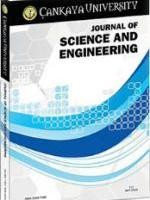On The Application of Homotopy Perturbation Method in Simulating the Effect of Double Dose Vaccination on a Mathematical Model of Covid-19 Transmission Dynamics
On The Application of Homotopy Perturbation Method in Simulating the Effect of Double Dose Vaccination on a Mathematical Model of Covid-19 Transmission Dynamics
Covid-19, Vaccination, HPM, Mathematical Modelling.,
___
- O. M. Ogunlaran, and S. C. Oukouomi Noutchie, “Mathematical model for an effective management of HIV infection,” Hindawi Publishing Corporation, vol. 2016, no. 4217548, pp. 6, 2016. http://dx.doi.org/10.1155/2016/4217548.
- S. Ahmad, A. Ullah, A. Akgül, and D. Baleanu, “Theoretical and numerical analysis of fractal fractional model of tumor-immune interaction with two different kernels,” Alexandria Engineering Journal, vol. 61, no. 7, pp. 5735- 5752, 2022.
- A. Akgül, M. Inc, A. Kilicman, and D. Baleanu, “A new approach for one-dimensional sine-Gordon equation,” Advances in Difference Equations, 2016. http://dx.doi.org/10.1186/s13662-015-0734-x.
- S. Balamuralitharan, and S. Geethamalini, “Solutions of epidemic of EIAV infection by HPM,” Journal of Physics: conf.series 1000, 012023, 2018.
- A. I. Alaje, M. O. Olayiwola, M. O. Ogunniran, J.A. Adedeji, and K. A. Adedokun, “Approximate Analytical Methods for the Solution of Fractional Order Integro-differential Equations,” Nigerian Journal of Mathematics and Applications, vol. 31, pp.175 – 190, 2021.
- S. A. Lauer, K. H. Grantz, Q Bi, F. K. Jones, Q. Zheng, H. R. Meredith, A.S. Azman, N.G. Reich, and J. Lessler “The incubation period of coronavirus disease 2019 (COVID-19) from publicly reported confirmed cases: estimation and application,” Ann. Internal Med., vol. 172, no. 9, pp. 577–582, 2020.
- Q. Li, X. Guan, and P. Wu, “Early transmission dynamics in Wuhan, China, of novel coronavirus–infected pneumonia,” New England Journal of Medicine, vol. 382, no. 13, pp. 1199–1207, 2020.
- C. Lai, T. Shih, W. Ko, H. Tang, and P. Hsueh, “Severe acute respiratory syndrome coronavirus the challenges,” International Journal of Antimicrobial Agents, vol. 55, no. 3, 2020.
- D. Rio, and P. N. Malani, “Covid-19. New insights on a rapidly changing epidemic,” JAMA, vol. 323, no. 14, pp. 1339-1340, 2020.
- O. A. Adegboye, A. I. Adekunle, and E. Gayawan, “Early transmission dynamics of novel coronavirus (COVID-19) in Nigeria,” Int. J. Environ. Res. Public Health, vol. 17, no. 3054, pp. 1–10, 2020.
- D. Kalyan, G. K. Ranjith, R. Madhusudhan, and K. Lakshminarayan, “Sensitivity and elasticity analysis of novel corona virus transmission model: A mathematical approach,” Sensors International, vol. 2, 1999.
- C. Xu, M. Farman, A. Hasan, A. Akgül, M. Zakarya, W. Albalawi, and C. Park, “Lyapunov stability and wave analysis of Covid-19 omicron variant of real data with fractional operator,” Alexandria Engineering Journal, vol. 61, no. 12, pp. 11787–802, 2022.
- G. Hussain, T. Khan, A. Khan, M. Inc, G. Zaman, K. Sooppy Nisar, and A. Akgül, “Modeling the dynamics of novel coronavirus (COVID-19) via stochastic epidemic model,” Alexandria Engineering Journal, vol. 60, no. 4, pp. 4121- 4130, 2021.
- J. H. He, “Homotopy perturbation technique,” Comput. Methods. Appl. Mech. Eng., vol. 178, pp. 257, 1999.
- Yayın Aralığı: Yılda 2 Sayı
- Başlangıç: 2009
- Yayıncı: Çankaya Üniversitesi
A Generalized Series Solution of ??? Order Ordinary Differential Equations
Adebisi A. IBRAHİM, Emmanuel ADEYEFA
Pseudo-spectrum and the Numerical Range for Ricci Tensor on the Oscillator Group of Dimension Four
Bendehiba MENAD, Derkaoui RAFİK
Pseudo-spectrum and Numerical Range of Matrices Walker of Dimension Three
Khalef BOUİCH, Derkaoui RAFİK, Abderrahmane SMAIL
Sefiu ONİTİLO, Muhammad USMAN, Deborah DANIEL, Tola ODULE, Ajoke SANUSİ
Convergent Result for Linear Conformable Pseudo-parabolic Equation
Tuan NGUYEN ANH, Ngo HUNG, Hoang Luc NGUYEN
Mutairu KOLAWOLE, Tawakalt A. BOSEDE, Adedapo ALAJE, Kehinde A. BASHİRU, Kehinde Adekunle BASHİRU
